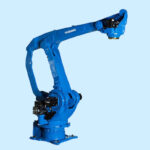ASIA ELECTRONICS INDUSTRYYOUR WINDOW TO SMART MANUFACTURING
Beckhoff Offers New Compact Multi-Axis System
Beckoff Automation GmbH has introduced Automation Technology for Robotics (ATRO), a new concept for robotics applications. To illustrate, the modular system from which the right robot kinematics can suit flexibly for any application. A highlight of the system is the internal media feed for data, power, and fluids. Best of all, this has been implemented so that all axes can rotate endlessly.
With ATRO, users can create almost any robot design for their application from the modules provided. Hence, from a simple 1-axis rotary indexing table application and delta kinematics through to multi-axis articulated robots. Beckhoff’s holistic perspective is decisive for simple commissioning and handling.
For that reason, only the direct integration of the robot system into PC-based control enables a truly optimized complete automation solution for the machine or plant. This reduces the number of controls needed on one industrial PC, even with multiple robots.

Advantages, Other Features
ATRO kinematics consist of active joints – the motor modules. Moreover, the motor modules are available in different designs. Particularly, the straight modules in I-shape or angled modules in L-shape. They come in five power sizes. Each motor module forms a complete drive system for one axis of the robot. The only external components required are a power supply and a control, which significantly reduces the space required in the control cabinet.
In addition, aside from the active modules, there are connection modules without their own drive. These include base modules as a base including the media feed. In addition, link modules with I, L, and Y-shapes for implementing individual robot configurations. Finally, the system modules that can integrate additional functions such as a camera.
The ATRO interface interconnect all modules and guarantees a rigid connection. In addition, the interface also passes through the media fed in. Data, power, and fluids (compressed air, vacuum, or water). Thus, guided internally through the modules in the ATRO kinematics. Conventional robotic solutions, on the other hand, route them externally and are therefore limited in rotation and use of the workspace.
This limitation is completely eliminated with the Beckhoff solution – each axis can be rotated endlessly, which enables better Cartesian accessibility as well as short positioning paths. Furthermore, interfering contours, e.g. due to externally located cables and, especially in the case of cobots, interfering torques, are avoided by means of external media feed. In addition, the media supplied again for a customer application via the ATRO interfaces. This allows integration of almost any robotic tools, such as sophisticated gripper systems.
Combines Essential Functions
Moreover, with ATRO, Beckhoff offers a highly flexible robot system that has all essential machine functionalities. This is because of its deep integration into the TwinCAT automation software. These include, for example, image processing for sophisticated applications (“bin picking”), improvement of motion performance through machine learning or direct cloud integration for analysis and maintenance.
In addition, the use of open interfaces and universal standards enables plug-and-play of the created robot configuration as well as simple engineering. Hence, this variety of functions concentrated in one control minimizes hardware costs. Also, it ensures maximum synchronization of all components as well as low delays in data communication. This also includes the direct combination with intelligent transport solutions such as XTS and XPlanar.
Meanwhile, it is also possible to create actual application with little effort in other areas such as communication and functional safety. This not only enables the configuration of an extremely powerful overall solution with maximized system output, but also a previously unattainable reduction in machine footprint.




